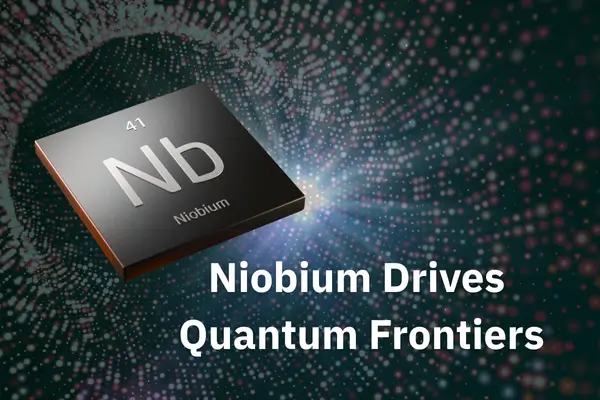Niobium (Nb) is more than a niche refractory metal, it’s a cornerstone material for next-generation electronics, superconducting devices, and quantum technologies.[1] Its unique combination of superconducting, thermal, and corrosion-resistant properties makes it essential for systems that demand extreme performance, operate at cryogenic temperatures, or function in challenging environments.
In this blog, we’ll explore why niobium is so valuable to advanced electronics and quantum materials research, and how thin-film deposition technologies like electron beam evaporation (e-beam) are enabling its use in cutting-edge applications.
Unique Material Properties of Niobium
Niobium’s exceptional performance stems from its unique combination of superconductivity, thermal stability, and corrosion resistance, making it a versatile material for both research-grade devices and industrial-scale applications. With a superconducting transition temperature (Tc) of approximately 9.25 K, niobium ranks among the highest of elemental superconductors, enabling efficient energy transfer at cryogenic temperatures. Its high melting point of 2,468 °C makes it ideal for high-vacuum and high-temperature processes, while its ductility allows it to be easily formed into wires, thin films, or intricate geometries. Additionally, niobium exhibits excellent corrosion resistance, particularly in acidic environments, ensuring long-lasting durability in cryogenic setups. These key properties position niobium as a material of choice for cutting-edge quantum and superconducting technologies. [2]
Niobium in Superconducting Electronics
Niobium is the industry standard for superconducting electronics, enabling zero-resistance current flow and ultra-low energy loss.[3]
Applications:
- Niobium plays a pivotal role in the functionality of Josephson junctions due to its superconducting properties, which are critical for enabling qubits in quantum computing. The material’s low microwave loss and robust superconducting characteristics ensure stable, high-fidelity quantum operations. Additionally, niobium’s ability to form high-quality Josephson junctions underpins the Rapid Single Flux Quantum (RSFQ) circuits, which leverage fluxons for ultra-fast, low-power digital processing. This combination of properties drives significant advancements in quantum processors, enhancing both quantum computing systems and energy-efficient superconducting digital logic. [4]
- Niobium is integral to the performance of Superconducting Nanowire Single-Photon Detectors (SNSPDs), as its superconducting properties ensure ultra-low dark counts and high efficiency in photon detection. The material’s low thermal noise and fast response time make niobium-based SNSPDs ideal for secure Quantum Key Distribution (QKD) and quantum cryptography. By leveraging niobium’s robust superconducting characteristics, SNSPDs enable advanced optical systems, enhancing the capabilities of quantum communication networks and supporting long-distance, high-security quantum data transmission.[5]
- Niobium’s superconducting properties are crucial for the performance of High-Q microwave resonators, offering ultra-low energy loss and high precision necessary for photon manipulation in quantum systems. The material’s low-loss characteristics ensure efficient control of photon states, which is vital for quantum information processing and secure communication. In cryogenic circuits, niobium-based resonators enable the development of scalable quantum processors, laying the foundation for advanced quantum technologies and facilitating the next generation of quantum computing systems.[6]
Niobium thin films, typically deposited via magnetron sputtering [7], molecular beam epitaxy (MBE)[8], or electron beam evaporation[9], offer reproducible Tc values and compatibility with silicon-based fabrication.
Niobium’s Role in Quantum Materials Research
Quantum devices require ultra-pure, low-loss superconductors to achieve long coherence times and scalability. Niobium excels because of:
- Niobium’s low microwave loss is crucial for enhancing the performance of superconducting resonators and qubits. Its high-quality factor (Q-factor) minimizes energy dissipation, enabling stable quantum states for quantum computing applications. This makes niobium ideal for scalable quantum processors and low-loss quantum circuits.[10]
- Niobium’s hybrid compatibility enables seamless integration with semiconductors, dielectrics, and 2D materials, enhancing device performance. This versatility supports the development of advanced quantum circuits and high-performance sensors. Its adaptability makes niobium a key material for next-generation quantum and hybrid electronic technologies.[11]
- The self-passivating oxide layer (Nb₂O₅) on niobium helps minimize contamination, ensuring stable surface properties. This natural oxide layer improves the material’s resilience and preserves quantum performance by reducing unwanted interactions. Nb₂O₅ enhances the longevity and reliability of superconducting devices and quantum circuits.[12]
In superconducting qubit platforms, niobium is used for resonator cavities, flux bias lines, and control circuitry, enabling stable, low-decoherence operation.
Niobium Thin Film Deposition: Why Electron Beam Evaporation Matters
For advanced electronics, niobium is commonly utilized as a thin film, and the quality of its deposition is crucial for optimal performance. While sputtering is a widely used technique, electron beam evaporation[9] (E-beam) offers distinct advantages for achieving high-purity niobium films. The e-beam directly melts the niobium under ultra-high vacuum conditions, minimizing contamination and ensuring ultra-pure deposition. This method also provides precise control over film thickness, which is essential for the fabrication of superconducting quantum devices. Additionally, E-beam deposition results in minimal substrate damage, making it particularly suitable for delicate dielectrics and semiconductor wafers, where preservation of material integrity is crucial.
Mini e-beam evaporators allow research teams and manufacturers to produce high-quality niobium films in-house without the footprint or complexity of full-scale deposition systems. This enables faster prototyping of superconducting circuits, quantum resonators, and hybrid devices.[13]
Nikalyte’s mini e-beam evaporators deliver high-purity, precisely controlled niobium coatings for superconducting electronics, quantum devices, and advanced sensors.
The Future of Niobium in Advanced Electronics
As quantum computing, superconducting detectors, and cryogenic electronics mature, niobium will remain central to progress. Future innovations in niobium alloying, nanostructuring, and interface engineering may further boost performance, enabling new architectures such as:
- Niobium-based superconducting spintronics leverage the interplay between superconductivity and spin-polarized currents for ultra-low power logic. These devices offer energy-efficient solutions by minimizing resistive losses and enabling high-speed operations at cryogenic temperatures. Their integration into quantum and classical computing systems promises scalable, low-power logic circuits with enhanced performance.[14]
- Niobium-integrated superconducting-photonic devices enable efficient coupling between quantum circuits and photonic systems for advanced quantum networking. These devices leverage niobium’s low-loss superconductivity to enhance photon detection, generation, and manipulation at cryogenic temperatures. Their integration facilitates scalable, high-fidelity quantum communication systems, driving the next generation of quantum networks.[15]
Conclusion
Niobium is not just another specialty metal, it is a key enabler of superconducting circuits, quantum technologies, and advanced cryogenic electronics. Its unmatched combination of superconducting performance, process compatibility, and long-term stability make it indispensable for the next generation of high-performance systems.
Contact us to speak with a technical expert about how our mini e-beam evaporators can optimize your niobium deposition process for quantum materials and advanced electronics.
References
- McCaffrey, D. M., Nassar, N. T., Jowitt, S. M., Padilla, A. J., & Bird, L. R. (2022). Embedded critical material flow: The case of niobium, the United States, and China. Resources, Conservation and Recycling, 186, 106698. https://doi.org/10.1016/j.resconrec.2022.106698
- Khalid, M. U., Rudokaite, A., da Silva, A. M. H., Kirsnyte-Snioke, M., Stirke, A., & Melo, W. C. M. A. (2025). A comprehensive review of niobium nanoparticles: Synthesis, characterization, applications in health sciences, and future challenges. Nanomaterials, 15(2), 106. https://doi.org/10.3390/nano15020106
- Hätinen, J., Ronzani, A., Loreto, R. P., Mykkänen, E., Kemppinen, A., Viisanen, K., Rantanen, T., Geisor, J., Lehtinen, J. S., Ribeiro, M., Kaikkonen, J.-P., Prakash, O., Vesterinen, V., Förbom, C., Mannila, E. T., Kervinen, M., Govenius, J., & Prunnila, M. (2024). Efficient electronic cooling by niobium-based superconducting tunnel junctions. Physical Review Applied, 22(6), 064048. https://doi.org/10.1103/PhysRevApplied.22.064048
- Yu, S., Chen, L., Pan, Y., Wang, Y., Zhang, D., Wu, G., Fan, X., Liu, X., Wu, L., Zhang, L., Peng, W., Ren, J., & Wang, Z. (2023). Gate-tunable critical current of the three-dimensional niobium nanobridge Josephson junction. Nano Letters, 23(17), 8043–8049. https://doi.org/10.1021/acs.nanolett.3c02015
- Natarajan, C. M., Tanner, M. G., & Hadfield, R. H. (2012). Superconducting nanowire single-photon detectors: Physics and applications. Superconductor Science and Technology, 25(6), 063001. https://doi.org/10.1088/0953-2048/25/6/063001
- de Ory, M. C., Rodriguez, D., Magaz, M. T., Rollano, V., Granados, D., & Gomez, A. (2024). Low loss hybrid Nb/Au superconducting resonators for quantum circuit applications. arXiv. https://doi.org/10.48550/arXiv.2401.14764
- Gao, H., Wang, S., Xu, D., Wang, X., Zhong, Q., Zhong, Y., Li, J., & Cao, W. (2022). Study of DC magnetron sputtered Nb films. Crystals, 12(1), 31. https://doi.org/10.3390/cryst12010031
- Iovan, A., Pedeches, A., Descamps, T., Rotella, H., Florea, I., Semond, F., & Zwiller, V. (2023). NbN thin films grown on silicon by molecular beam epitaxy for superconducting detectors. Applied Physics Letters, 123(25), 252602. https://doi.org/10.1063/5.0175699
- Bromley, D., Wright, A. J., Jones, L. A. H., Swallow, J. E. N., Beesley, T., Batty, R., Weatherup, R. S., Dhanak, V. R., & O’Brien, L. (2022). Electron beam evaporation of superconductor-ferromagnet heterostructures. Scientific Reports, 12(1), 7786. https://doi.org/10.1038/s41598-022-11828-y
- Verjauw, J., Potočnik, A., Mongillo, M., Acharya, R., Mohiyaddin, F., Simion, G., Pacco, A., Ivanov, Ts., Wan, D., Vanleenhove, A., Souriau, L., Jussot, J., Thiam, A., Swerts, J., Piao, X., Couet, S., Heyns, M., Govoreanu, B., & Radu, I. (2021). Investigation of microwave loss induced by oxide regrowth in high-Q niobium resonators. Physical Review Applied, 16(1), 014018. https://doi.org/10.1103/PhysRevApplied.16.014018
- Liang, M., Yan, H., Wazir, N., Zhou, C., & Ma, Z. (2024). Two-dimensional semiconductors for state-of-the-art complementary field-effect transistors and integrated circuits. Nanomaterials (Basel), 14(17), 1408. https://doi.org/10.3390/nano14171408
- Tanji, A., Fan, X., Sakidja, R., Liaw, P. K., & Hermawan, H. (2024). Role of niobium on the passivation mechanisms of TiHfZrNb high-entropy alloys in Hanks’ simulated body fluid. Journal of Functional Biomaterials, 15(10), 305. https://doi.org/10.3390/jfb15100305
- (n.d.). UHV e-beam source. Nikalyte. https://www.nikalyte.com/uhv-e-beam-source/
- Tanatar, M. A., Torsello, D., Joshi, K. R., Ghimire, S., Kopas, C. J., Marshall, J., Mutus, J. Y., Ghigo, G., Zarea, M., Sauls, J. A., & Prozorov, R. (2022). Anisotropic superconductivity of niobium based on its response to nonmagnetic disorder. Physical Review B, 106(22), 224511. https://doi.org/10.1103/PhysRevB.106.224511
- Labonté, L., Alibart, O., D’Auria, V., Doutre, F., Etesse, J., Sauder, G., Martin, A., Picholle, É., & Tanzilli, S. (2024). Integrated photonics for quantum communications and metrology. PRX Quantum, 5, 010101. https://doi.org/10.1103/PRXQuantum.5.010101


